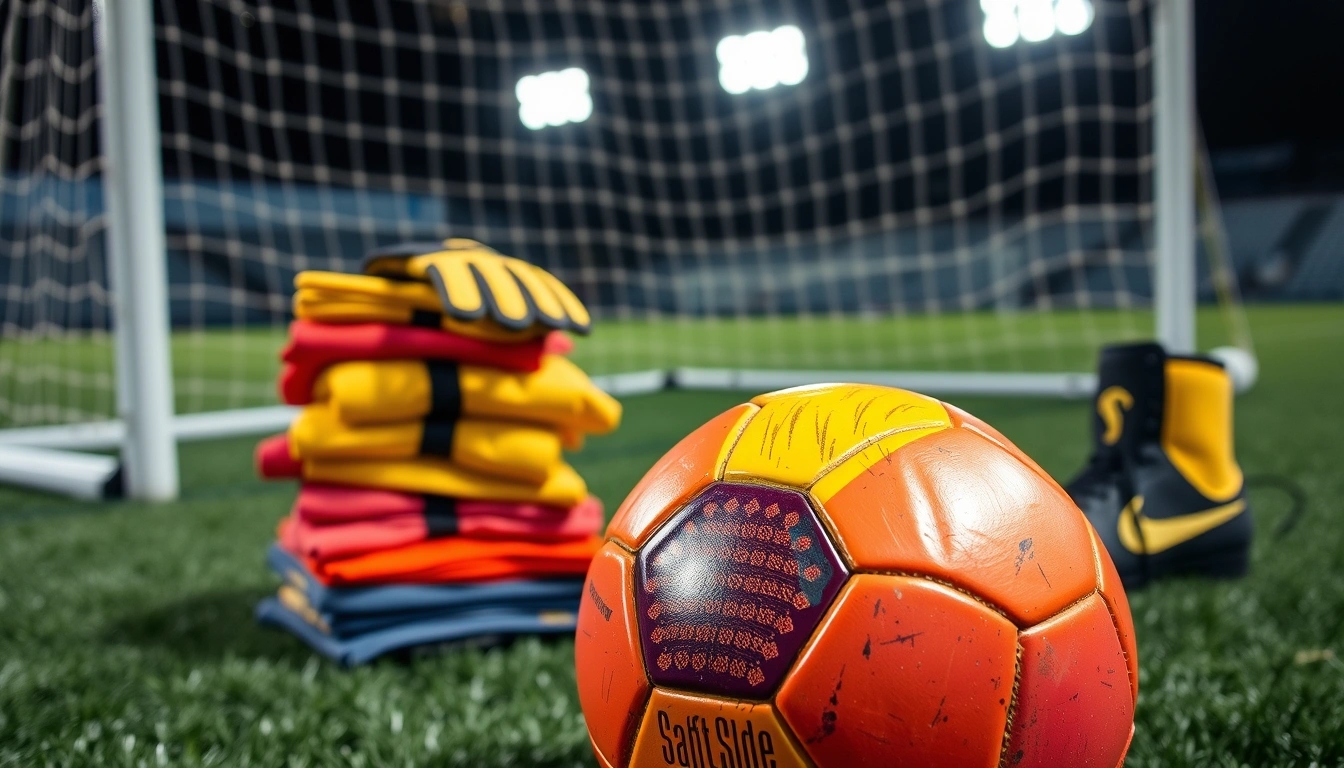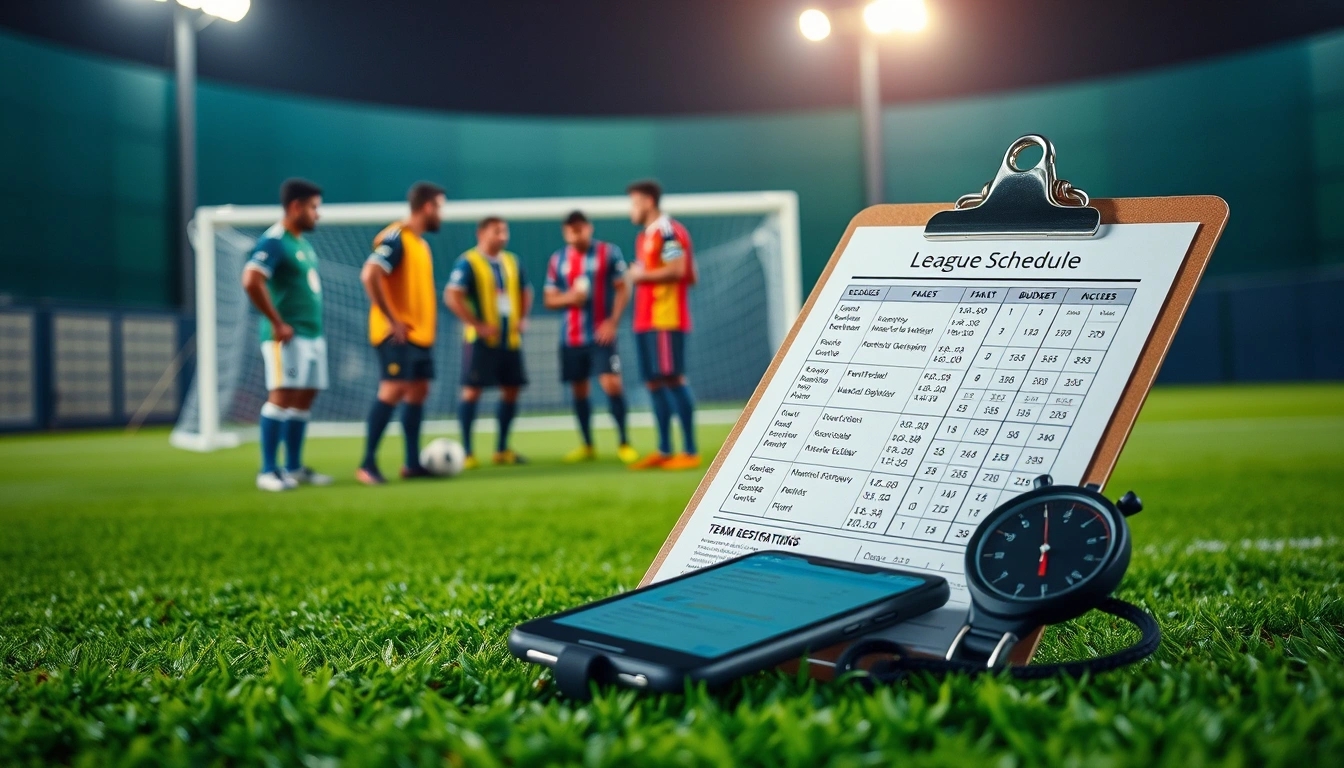Alright, so you’ve got this brilliant idea to start your own 5-a-side football league. Sounds easy, right? Just gather some mates, find a pitch, and boom—league on! Well, hold your horses. It’s a bit more tangled than that, but don’t sweat it. Here’s a down-to-earth guide to get you from “I want to play” to “Game on!” with a few laughs and maybe a little chaos thrown in for flavor.
Step 1: Choosing the Perfect Venue
Finding the right pitch is like finding the perfect pair of boots—it’s gotta fit just right. Location matters big time. You want somewhere accessible, preferably with decent lighting because, let’s face it, games often spill into the evening. Artificial turf is a winner here, but if you’re lucky enough to snag a decent grass pitch, don’t complain! Also, check the availability and cost. Some places charge an arm and a leg, others might be more wallet-friendly but a bit of a trek.
| Venue Factors | What to Look For |
|---|---|
| Location | Easy to reach by public transport or car |
| Surface | Artificial turf preferred, grass if well-maintained |
| Lighting | Good floodlights for evening matches |
| Facilities | Changing rooms, toilets, parking |
| Cost | Within your league’s budget |
Step 2: Deciding on League Format and Rules
Not every league is a carbon copy. You gotta tailor the format to your crowd. Match length? 20 minutes each half? 15? Maybe no halves and just 30 minutes straight? Team sizes? Obviously 5-a-side, but what about substitutes? Unlimited subs keep things fresh but can slow the game down. Rules? Standard FIFA or house rules? Maybe no slide tackles—because ouch!
- Match Duration: 30-40 minutes total is typical
- Substitutions: Rolling subs keep players fresh
- Fouls & Cards: Decide how strict you want to be
- Points System: Win 3 points, Draw 1, Loss 0 (classic!)
Step 3: Recruiting Teams and Players
This is where things get interesting. You might start with just your mates and a couple of randoms, but soon you’ll want more teams. Use social media like a pro—Facebook groups, WhatsApp chats, even that dusty noticeboard at the local pub. Don’t be shy to hit up local businesses, gyms, or schools. And if enthusiasm is low? Throw in some fun incentives—free drinks, trophies, or just the glory of bragging rights.
Pro Tip:If you’re struggling to get teams, consider a “draft day” where players sign up individually and you mix teams each week. Keeps things fresh and fair!
Step 4: Scheduling Matches and Fixtures
Now, here comes the headache—scheduling. You want games that don’t clash with everyone’s day job or Netflix binges. Use simple spreadsheets or apps like Google Calendar or TeamSnap. Keep communication clear and flexible; life happens, and sometimes games get postponed (or someone just ghosts).
| Scheduling Tips | Why it Matters |
|---|---|
| Set fixed days/times | Players plan their week better |
| Allow buffer weeks | For rescheduled matches |
| Use online tools | Easy updates and reminders |
| Communicate early | Minimizes no-shows |
Look, setting up a 5-a-side league isn’t all sunshine and rainbows, but with a bit of grit, some laughs, and a sprinkle of chaos (because it’ll happen), you’ll have a cracking league in no time. Just remember, it’s all about the love of the game—and maybe a bit of friendly rivalry.
Good luck, and may your goals be many and your disputes few!
Choosing the Perfect Venue
Alright, so you’ve decided to kick off your very own 5-a-side football league. First things first: finding the perfect pitch. Sounds simple, right? Well, not always. There’s more to it than just picking any old patch of grass or an empty parking lot. The venue can make or break your league before it’s even kicked off. So, what should you be eyeballing? Let’s break it down.
- Location, location, location: This isn’t just a real estate mantra. Your pitch needs to be accessible for most players. Think about public transport links, parking availability, and how close it is to where your players live or work. If your venue is hidden in the middle of nowhere, don’t be surprised if attendance starts looking like a ghost town.
- Surface type matters: Grass, artificial turf, concrete? Each has its quirks. Grass is classic but can get muddy and slippery, especially if the weather decides to throw a tantrum. Artificial turf is consistent and low-maintenance but might be a bit harsh on knees. Concrete? Well, that’s for the daredevils and risk-takers—expect more scrapes and bruises.
- Size and markings: A standard 5-a-side pitch is roughly 40m x 30m, but there’s some wiggle room depending on your space. Make sure the field has clear boundary lines and goals that fit the 5-a-side format. No one wants to play on a pitch that feels like a shoehorned afterthought.
Now, let’s toss in a little table to help you compare surface types quickly:
| Surface | Pros | Cons |
|---|---|---|
| Natural Grass | Soft on joints, classic feel, cooler underfoot | Weather-dependent, maintenance-heavy, can get muddy |
| Artificial Turf | Consistent surface, low maintenance, all-weather use | Can cause burns, harder on joints, expensive to install |
| Concrete/Asphalt | Easy to find, durable, cheap | Hard on bodies, risk of injury, no ball bounce control |
But wait, there’s more! Don’t forget about lighting. Evening matches are a staple for many leagues, especially if participants work 9 to 5. A poorly lit pitch? That’s a recipe for missed passes and accidental faceplants. If floodlights are on the pricey side, try to schedule games during daylight hours or consider venues with built-in lighting.
And here’s a little nugget of wisdom: visit the pitch at game time. It’s one thing to see a pitch on a sunny Sunday afternoon; it’s another to see it buzzing with players under floodlights on a Wednesday night. Check out the vibe, noise levels, and whether the facilities (toilets, changing rooms, parking) actually exist and aren’t just a fantasy.
- Is the venue safe? Look out for any dodgy areas around the pitch that might spook your players.
- Are there any restrictions? Some venues have strict rules on noise, alcohol, or timings. Better to know upfront than get a nasty surprise.
To sum up, the perfect venue is a blend of convenience, safety, surface quality, and facilities. It’s not just where you play; it’s where your league’s story begins. So, take your time, do your homework, and don’t be afraid to ask questions or test multiple venues before settling down. Your players (and their knees) will thank you.
Quick checklist for choosing your pitch:
- Accessible location (public transport + parking)- Suitable surface (grass, turf, or hardcourt)- Proper size and markings- Good lighting for evening games- Facilities: toilets, changing rooms, shelter- Safety and neighborhood vibe- Venue rules & restrictions
Remember, a well-chosen pitch sets the tone for your league. Skip this step or rush it, and you might find yourself chasing players instead of the ball. Good luck out there!
Deciding on League Format and Rules
So, you’re gearing up to set your own 5-a-side football league, and now comes the fun bit—figuring out how to actually run the show. But here’s the kicker: not all leagues are cut from the same cloth. What works for one group might be a total disaster for another. It’s like trying to fit a square peg in a round hole if you don’t tailor match lengths, team sizes, and rules to your players’ style and vibe. Let’s dive into the nitty-gritty and get those games flowing smoothly.
First off, match lengths. You might think “easy, let’s just do 20-minute halves and call it a day,” but hold your horses. Some players want quick-fire matches to keep energy levels high, while others prefer longer games for that classic, sweat-it-out feel. A good rule of thumb? Keep it flexible. Maybe start with 15-minute halves if your players are mostly casual and new to the game, or go up to 25 minutes if they’re seasoned and craving more action.
| Match Length | Player Type | Pros | Cons |
|---|---|---|---|
| 10-15 minutes | Beginners, casual players | Fast-paced, less tiring | Less time to settle into the game |
| 20-25 minutes | Intermediate to advanced | More tactical play, better rhythm | Can be tiring, longer wait times between matches |
Next on the chopping block: team sizes. Classic 5-a-side means five players per team, but hey, if your group is a bit smaller or bigger, why not tweak it? Teams of 4 or 6 can work just fine, but be mindful that changing numbers can throw off the game’s flow and strategy. For example, fewer players mean more running and open space, which can be exhausting but exciting.
- 4-a-side: Great for smaller groups, but expect more ground to cover.
- 5-a-side: The standard, balanced mix of space and teamwork.
- 6-a-side: Adds a bit more complexity and player involvement.
Rules—oh boy, this is where things get spicy. Do you want offside rules? Sliding tackles? How about allowing unlimited substitutions or just a few? It’s tempting to copy-paste from professional leagues, but remember, your league’s unique. Maybe your players love aggressive defense, or maybe they prefer a more chill, friendly vibe. So, customize those rules to suit your crowd.
Here’s a quick checklist to consider when setting rules:
- Substitutions: Rolling subs keep the game fresh and players happy.
- Fouls and cards: Decide how strict you want to be—are yellow cards a thing or just friendly warnings?
- Goalkeeper rules: Can they handle the ball outside the box? Are they allowed to punt it?
- Offside: Usually not enforced in 5-a-side, but you can implement a loose version if you want.
Pro Tip: Keep a simple, written rulebook handy and share it with everyone before the first match. Nothing kills the vibe faster than confusion or arguments over what’s allowed.
In the end, the key is adaptability. Don’t be afraid to tweak things mid-season if something’s not working. Your league is a living, breathing beast—treat it like one. Keep an ear open for feedback, watch how the games unfold, and don’t sweat the small stuff. After all, it’s football, not rocket science!

Recruiting Teams and Players
Alright, let’s get real for a moment — no league can kick off without players. Sounds obvious, right? But if you’re staring down the barrel of an empty pitch and wondering how to fill it, don’t panic just yet. Recruiting teams and players for your 5-a-side football league can feel like trying to sell ice to penguins, especially when your initial contacts are slim and enthusiasm is, well, pretty much on life support.
First things first: think local, think personal. Your best bet is to start with who you know — mates, work colleagues, that one guy from the pub who always swears he’s got mad skills but never shows up. Then, get creative. Post flyers in community centers, gyms, and coffee shops, but don’t just slap up a boring “Join our league” notice. Make it pop! Use humor, a catchy tagline, or even a cheeky challenge like “Think you can outscore the local legend? Prove it!”
| Recruitment Method | Pros | Cons |
|---|---|---|
| Word of Mouth | Personal touch, builds trust | Slow growth, limited reach |
| Social Media | Wide audience, easy to share | Can seem spammy, needs regular updates |
| Local Flyers & Posters | Targets local community | Easily ignored, costs time and money |
| Partnering with Local Businesses | Mutual benefits, sponsorship potential | Requires negotiation, not always reliable |
Now, if you’re scratching your head because nobody’s biting, try hosting a free trial session or a casual meet-up. Nothing hooks players like a bit of fun and a chance to test the waters without commitment. Plus, once people get a taste of the action, they’re much more likely to sign up. Don’t forget to snap some photos or videos — social proof is gold.
- Tip: Be welcoming to individual players too, not just full teams. Many leagues struggle because they expect pre-made teams to show up. Offering a way to join as a free agent and get placed on a team can swell your numbers faster than you think.
- Tip: Use social media groups or apps dedicated to local sports to post your league info. But keep it casual — nobody wants a robotic ad that screams “join now or else.”
One more thing — don’t get disheartened if enthusiasm is low at the start. It’s completely normal. Building a community takes time, and sometimes you have to weather a few quiet weeks before things start buzzing. Keep the vibe positive, engage with your early sign-ups personally, and celebrate every milestone, no matter how small.
Example Welcome Message for New Players:"Hey there! Thanks for signing up for our 5-a-side league. We’re stoked to have you on board. Whether you’re a seasoned pro or just here for the laughs, you’re part of the crew now. Get ready for some fun, friendly competition, and maybe a few epic goals (or fails). See you on the pitch!"
In the end, recruiting is less about having a perfect plan and more about being persistent, approachable, and a bit creative. So, dust off that megaphone, rally your friends, and remember: every great league started with just a handful of players showing up and saying, “Why not?”
Scheduling Matches and Fixtures
Trying to juggle calendars for a 5-a-side football league? Well, welcome to the club of sleepless organizers! Balancing everyone’s availability is like herding cats—if those cats also want to play football on Fridays, Saturdays, and occasionally during a full moon. But fear not, dear reader, because while it’s a headache, there are ways to dodge the scheduling disaster and keep your league running smoother than a well-oiled machine (or at least less like a broken clock).
First off, accept this truth: you’ll never make everyone 100% happy. Someone’s always got a work thing, a last-minute date, or just plain old laziness. So, the goal isn’t perfection—it’s compromise. Start by gathering all teams’ preferred days and times using simple tools like Google Forms or even a messy group chat where chaos reigns but info flows. This initial step is crucial because guessing won’t cut it.
- Tip 1: Use a shared calendar platform (Google Calendar or TeamSnap) so everyone can see fixtures in real time.
- Tip 2: Consider peak and off-peak times. Evening slots on weekdays might be popular but limited; weekends can be a free-for-all.
- Tip 3: Don’t forget to factor in daylight hours—especially if your venue has no floodlights. Nothing kills the vibe like a half-finished match at dusk.
Now, here’s a little table to help you visualize how to distribute matches evenly across a week without turning your league into a scheduling nightmare:
| Day | Preferred Match Times | Notes |
|---|---|---|
| Monday – Thursday | 6pm – 9pm | Great for after-work players; beware of overtime clashes |
| Friday | 6pm – 10pm | Popular but often tricky due to social plans |
| Saturday | 10am – 6pm | Ideal for longer tournaments or double-headers |
| Sunday | 10am – 4pm | Good fallback day; some players might prefer rest |
One thing many organizers overlook: build in buffer times. Matches rarely end exactly on time, and minor delays can cascade into a full-blown scheduling disaster. A 10-15 minute break between games keeps the flow and sanity intact. Plus, it gives players a chance to catch their breath—and maybe trash-talk a little.
- Pro tip: Try to avoid scheduling a team for back-to-back matches unless they’ve specifically asked for it. Fatigue is real, and cranky players cranky league.
- Heads up: Always have a backup plan for cancellations or no-shows—maybe a waiting list or a flexible reschedule policy.
And if you’re feeling adventurous, consider using scheduling software designed for sports leagues. They can automate much of the headache, but be warned—sometimes the algorithms spit out fixtures that make zero human sense. So, always review and tweak.
In the end, scheduling isn’t just about dates and times; it’s about keeping players engaged, motivated, and showing up. Mess it up, and your league could be a ghost town faster than you can say “offside.” Nail it, and you’ll have a buzzing, lively competition that folks will actually look forward to. So, roll up your sleeves, embrace the chaos, and remember—no plan survives contact with reality, but a good schedule sure helps.
Setting Up Registration and Fees
Alright, let’s talk about the elephant in the room—money. Setting up registration and fees for your 5-a-side football league isn’t just about slapping a price tag on participation. It’s a tightrope walk between covering your costs and not scaring off the very players you want to attract. Sounds simple? Well, not quite. But hey, if it were easy, everyone would be running leagues, right?
First off, registration. You want it smooth, painless, and as hassle-free as possible. Nobody enjoys filling out endless forms or chasing down payment details. Consider using online platforms—there are plenty of user-friendly tools out there that let players sign up, pay, and even get updates without you breaking a sweat. And yes, this means less paperwork for you and fewer excuses from players about “forgot to pay.”
- Tip: Keep registration open for a reasonable window, but don’t drag it out forever. A deadline creates urgency and helps you plan better.
- Tip: Collect essential info only—name, contact, emergency details, and any medical notes. No need to turn it into a novel.
Now, onto the sticky subject of fees. How much should you charge? Here’s the kicker: charge too much, and you might lose players faster than a bad ref blows a whistle. Charge too little, and you’ll be out of pocket quicker than you can say “goal.”
| Fee Component | What It Covers | Notes |
|---|---|---|
| Pitch Rental | Hourly cost of the playing surface | Book in advance to lock in rates |
| Referee Fees | Payment for official match referees | Optional if players self-ref, but risky |
| Equipment | Balls, bibs, cones, first aid kits | Initial purchase, then occasional replacements |
| Admin Costs | Website hosting, registration platform fees | Often overlooked but adds up |
Don’t forget to factor in a small buffer for unexpected expenses—like that time the ball mysteriously vanished or the pitch needed emergency repairs. Transparency here is your friend. Make sure players know what their fees are paying for. Nobody likes hidden costs popping up like a surprise red card.
- Pro tip: Consider tiered pricing—discounts for early birds, group sign-ups, or returning players. It’s a nice carrot to dangle.
- Warning: Avoid complicated fee structures. If it takes a spreadsheet wizard to explain, you’ve gone too far.
Budgeting? Oh boy. It’s tempting to wing it, but a shaky budget is like a dodgy defender—liable to let you down at the worst moment. Track your income and expenses religiously. Use simple spreadsheets or budgeting apps—no need to get fancy. Keep a close eye on cash flow so you’re not left scrambling mid-season.
In the end, remember: money talks, but it shouldn’t scream. Your goal is to make participation feel like a bargain, not a burden. If you get this right, you’ll have players coming back season after season, and maybe even some extra cash to upgrade those kits or snag a better pitch. Now that’s a win-win.

Equipment and Kit Essentials
Alright, so you’re gearing up to kick off your own 5-a-side football league, and naturally, you’re wondering what gear you really need versus what you can totally skip without turning the whole thing into a disaster. Spoiler alert: safety gear isn’t just important—it’s absolutely non-negotiable. But beyond that, there’s a bit of wiggle room. Let’s break it down, no fluff, just the essentials and some helpful tips to keep your league rolling smoothly.
First off, the obvious star of the show: the footballs. You’ll want good quality balls that can withstand frequent use on whatever surface you’ve chosen—artificial turf, indoor courts, or even concrete if you’re brave. Don’t go for the cheapest balls you find in a bargain bin; they’ll deflate or burst faster than you can say “goal.” Aim for something in the middle price range, something durable but not bank-breaking. Having a few extras on hand is smart because, well, balls do get lost or mysteriously disappear.
| Equipment | Must-Have? | Notes |
|---|---|---|
| Football(s) | Yes | Get durable, size 4 or 5 depending on age group. |
| Bibs (Team Jerseys) | Yes | Essential for team distinction; reversible bibs save money. |
| Goalkeeper Gloves | No, but recommended | Optional, but appreciated by keepers. |
| Shin Guards | Absolutely Yes | Safety first—no exceptions here. |
| Cones/Markers | Yes | For drills and marking boundaries. |
| Referee Whistle | Yes | To keep order and stop chaos. |
Now, bibs—those colorful vests that let you tell your team from the opposition without squinting—are a must. You can go fancy with printed jerseys, but honestly, reversible bibs do the trick and save you some cash. Plus, they’re easy to wash and reuse. Just make sure you have enough for all players, and maybe a few spares for last-minute subs or “that one guy who forgot his colors.”
Safety gear? Don’t even think about skimping here. Shin guards are the unsung heroes of football safety. No one wants a nasty shin contusion or worse, and trust me, you’ll regret not enforcing this rule when someone gets hurt. Make it crystal clear in your league rules that shin guards are mandatory—no exceptions, no “I forgot” excuses. It’s a small investment for peace of mind.
- Extra Tips:
- Encourage players to bring their own boots, but remind them to check the surface type (indoor shoes for indoor courts, cleats for turf).
- Keep a first aid kit handy—scrapes and bumps happen, and you don’t want to be caught empty-handed.
- Consider having a few spare balls and bibs on hand to avoid game delays.
And hey, while we’re on gear, don’t forget the less glamorous but essential stuff like cones for marking out the pitch and a referee whistle to keep those matches in check. You might think you can do without a whistle, but trust me, shouting “foul!” doesn’t quite cut it when tempers flare.
In conclusion, focus your budget and energy on the essentials: good balls, bibs, and safety gear. Everything else? Nice to have, but not deal breakers. Remember, it’s about making the game enjoyable and safe, not turning into a pro club overnight. So, gear up smartly, keep it simple, and let the games begin!
Refereeing and Fair Play
Refereeing and Fair Play: Keeping the Game in Check
Alright, so you’ve got your 5-a-side league up and running, teams buzzing, balls flying—but who’s gonna keep an eye on the chaos? Refereeing isn’t just about blowing whistles and waving cards; it’s the backbone of fair play and sanity on the pitch. Without someone to call out fouls or calm tempers, you might as well be watching a rugby scrum instead of a football match.
First off, let’s talk options for referees. You’ve got a few routes here:
- Official Referees: Hiring certified refs is the gold standard, but it can be pricey and tricky to schedule.
- Player Refereeing: Sometimes leagues go self-ref, where players take turns officiating. Sounds democratic, but beware of bias and missed calls.
- Volunteer Refs: Local enthusiasts or parents who want in on the action without breaking the bank.
Each choice comes with its own headaches. Official refs bring authority but can feel stiff or out of touch with your league’s vibe. Player refs? Well, that’s a recipe for some heated “offside” arguments and maybe a few grudges.
Now, about fair play policies. This is where you set the tone for respect and sportsmanship. Drafting a simple code of conduct can do wonders, like:
- No aggressive behavior or trash talking beyond playful banter.
- Respect referees’ decisions—even if you think they’re blind.
- Encourage helping fallen players, not kicking them while they’re down.
- Zero tolerance for discriminatory language or actions.
| Fair Play Policy | Why It Matters |
|---|---|
| Respect for Officials | Maintains authority and smooth game flow, avoids constant disputes |
| Sportsmanship | Builds camaraderie and keeps the league fun for everyone |
| Zero Tolerance Rules | Ensures a safe and inclusive environment |
Of course, even with the best policies, tempers flare. It’s a fact of life when you cram 10 players into a small pitch, chasing a ball with sweat and adrenaline flying. Keeping the peace means being ready to step in, cool heads prevailing, and sometimes just letting a minor scuffle blow over (unless it’s serious, then you gotta act fast).
Here’s a quick checklist for managing flare-ups:
- Have a clear, published disciplinary process.
- Train referees to de-escalate tension, not just hand out cards.
- Encourage captains to set examples and manage their squads.
- Don’t hesitate to bench players who cross the line.
Remember, the goal is to keep the game competitive but fun. Nobody wants a league where every match feels like a boxing match with a ball. So, whether you’re recruiting a pro ref or trusting players to keep it fair, make sure your league’s spirit stays in the game.
To wrap it up, refereeing and fair play aren’t just administrative chores—they’re the lifeblood of your league’s reputation and longevity. Nail this part, and you’ll have players coming back season after season, even if they grumble about that one dodgy call now and then.
Tips for Referees:- Stay neutral, even if your mate’s playing.- Keep communication clear and calm.- Use cards wisely; don’t be trigger-happy.- Remember, you’re there to facilitate fun, not just enforce rules.
So, who’s blowing the whistle in your league? Choose wisely, set clear rules, and keep the peace—because without that, your 5-a-side league might just turn into a gladiator arena. And trust me, no one wins there.
Marketing Your League
So, you’ve got your 5-a-side football league all set up, teams ready to rumble, but now comes the tricky bit—getting people to actually care. Marketing your league isn’t about shouting from the rooftops like a desperate street vendor, no sir. It’s about smart, subtle, and sometimes downright sneaky ways to get your league noticed without sounding like you’re begging for attention. Let’s dive into some no-nonsense tips that’ll help you spread the word like wildfire.
- Social Media is Your Best Mate: Forget just posting match results. Get creative! Share behind-the-scenes sneak peeks, funny bloopers, and player spotlights. People love a good story, so make your posts relatable and engaging. Use Instagram reels, TikTok clips, or even goofy memes to grab eyeballs. And don’t just post and ghost—engage with comments and messages. It’s a two-way street, not a megaphone.
- Local Press: Old School Works: Believe it or not, local newspapers and community bulletins still hold weight. Send out press releases about your league’s kickoff, highlight standout players, or announce charity matches. Keep it short, sweet, and newsworthy. Editors get bombarded daily, so make your pitch punchy and relevant.
- Word-of-Mouth: The Secret Weapon: Nothing beats a good old chat over a pint. Encourage your players to bring friends, family, and even their annoying neighbors. Maybe offer a small discount or freebies for referrals—everyone loves a good deal. But remember, don’t push too hard or you’ll sound like a telemarketer from hell.
| Marketing Channel | Tips | Common Pitfalls |
|---|---|---|
| Social Media |
|
|
| Local Press |
|
|
| Word-of-Mouth |
|
|
Now, if you’re thinking, “Great, but I don’t have a marketing budget,” don’t sweat it. Most of these strategies cost nothing but a bit of your time and creativity. Here’s a quick rundown of practical steps you can start with:
1. Create a simple league logo and use it on all posts.2. Set up a Facebook page and a WhatsApp group for quick updates.3. Reach out to local sports bloggers or influencers for shoutouts.4. Host a launch event or mini-tournament to create buzz.5. Encourage players to share their match highlights on their own socials.
Remember, the goal is to build a community, not just fill slots. Keep your tone friendly, genuine, and a bit cheeky—people respond better to personality than polished corporate speak. And if you mess up a post or two? No biggie. It’s all part of the charm.
In the end, marketing your league is like playing a good game of football: it’s about teamwork, timing, and a little bit of flair. So get out there, make some noise (the right kind), and watch your league grow from a small kickabout to the talk of the town.
Pro Tip: Don’t forget to track what works and what doesn’t. Use simple tools like Google Analytics for your website or insights on social media platforms to tweak your strategy. Because, let’s face it, winging it is fun but winning is better.
Good luck, manager—may your league be as lively off the pitch as it is on it!

Handling Disputes and Discipline
Let’s face it: in any 5-a-side football league, disputes are as inevitable as that one player who insists on playing goalie even though they’re clearly better at scoring own goals. Arguments will happen. It’s part of the game, part of the passion, and sometimes just part of people being, well, people. The real trick? Knowing how to manage conflicts and enforce discipline without turning into a tyrant who scares everyone off or a pushover who lets chaos reign.
First off, don’t pretend that disagreements won’t pop up. They will. Whether it’s a questionable tackle, a disputed goal, or a referee’s call that has everyone seeing red, emotions run high. Your job as a league organizer or referee is to keep a cool head and set the tone. If you lose it, the whole league can spiral into a playground brawl faster than you can say “offside.”
- Stay Neutral: No favorites, no grudges. Treat every complaint and every player the same. If you’re seen as fair, people are more likely to respect your decisions—even the tough ones.
- Listen Actively: Sometimes, just letting players vent their frustrations calms things down. Don’t cut them off or dismiss their concerns outright.
- Set Clear Rules: Before the season kicks off, make sure everyone knows what’s allowed and what’s not. Ambiguity is a breeding ground for disputes.
| Common Disputes | Suggested Handling Approach |
|---|---|
| Foul Play | Issue warnings first; repeated offenses lead to suspensions. |
| Referee Decisions | Encourage respect for calls; consider a review system if possible. |
| Team Conduct | Enforce a code of conduct; penalize poor sportsmanship. |
Now, discipline is a delicate dance. You want to keep the league competitive and fun, but without turning it into a free-for-all where the loudest or toughest bully wins. Striking that balance is tricky. If you’re too harsh, you risk alienating players who just want to enjoy their Friday night kickabout. Too lenient, and you’ll have players pushing boundaries like it’s the World Cup final.
Here’s a quick checklist to keep discipline in check without becoming the dreaded “league dictator”:
- Consistency: Apply rules evenly. No “special treatment” because someone’s your buddy or the top scorer.
- Transparency: Explain why you’re handing out penalties. Nobody likes a mystery punishment.
- Encourage Self-Regulation: Promote respect among players and teams. Peer pressure can be a powerful tool.
- Have a Clear Appeal Process: Let players know they can raise concerns calmly and get a fair hearing.
Example: Player A argues with the referee after a red card. Instead of escalating, the referee calmly explains the foul, reminds Player A of the league rules, and offers a chance to appeal after the match. Player A cools down and accepts the decision.
In the end, remember: you’re not running a dictatorship, you’re running a league. The goal is to keep the spirit of the game alive, not to stamp out every little flare-up with an iron fist. Embrace the chaos, keep your cool, and you’ll find that disputes become less about drama and more about the passion that makes football so addictive.
So, don’t sweat the arguments too much. With the right approach, they can actually bring your league closer together — or at least give everyone a good story to tell at the pub afterward.
Using Technology for Management
So, you’ve got your 5-a-side league up and running, but now comes the real headache: keeping everything organized without losing your mind. Let’s be honest, managing a league can feel like juggling flaming footballs while riding a unicycle—exciting but a tad chaotic. Thankfully, technology is here to save the day, or at least to make your life a bit less stressful. Whether you’re a tech wizard or someone who still thinks “apps” are just a fancy word for snacks, there’s a tool out there for you.
First off, forget the old-school smoke signals or endless WhatsApp chains that get lost in a sea of emojis and “who’s playing tonight?” messages. Instead, consider apps designed specifically for sports leagues. Platforms like TeamSnap, LeagueApps, or SportEasy offer everything from player registration and fee tracking to match scheduling and live score updates. They’re like your league’s personal assistant, minus the coffee runs.
- Player Management: Keep track of who’s on your teams, their contact details, and availability.
- Scheduling: Automatically generate fixtures and send reminders so no one forgets their game (looking at you, latecomers).
- Payments: Collect fees online, reducing the awkward “where’s my money?” conversations.
But hey, what if your league is still in its infancy and you’re not ready to commit to a paid app? No worries, spreadsheets are your trusty sidekick. Google Sheets or Excel can do wonders if you’re willing to put in a bit of elbow grease. Create tabs for teams, players, fixtures, and payments. Use conditional formatting to highlight unpaid fees or upcoming matches. It’s low-tech but effective.
Example Spreadsheet Layout:-------------------------------------------------| Teams | Players | Fixtures |-------------------------------------------------| Team A | John, Mike | 01/05 Team A vs Team B || Team B | Sarah, Dave | 08/05 Team A vs Team C |-------------------------------------------------| Payments | Status | Notes |-------------------------------------------------| John | Paid | || Mike | Pending | Reminder sent |-------------------------------------------------
Now, if you’re the type who likes to live dangerously, you could always mix and match tools. Use a scheduling app but keep payments on a spreadsheet, or manage player availability via a shared calendar. Just don’t get too fancy or you’ll spend more time clicking than playing.
| Tool Type | Pros | Cons |
|---|---|---|
| Dedicated Apps | All-in-one solution, automated reminders, easy payments | May require subscription, learning curve |
| Spreadsheets | Free, customizable, familiar to many | Manual updates, prone to errors |
| Hybrid Approach | Flexible, tailored to needs | Can get confusing, time-consuming |
At the end of the day, the best tool is the one you’ll actually use. Don’t get caught in the trap of endlessly searching for the “perfect” system—sometimes good enough is just fine. And remember, a bit of chaos is part of the charm of grassroots football. So grab your phone, pick a tool, and get back to what really matters: the beautiful game.
Pro Tip: Set aside a weekly “tech check” time to update your tools and communicate with players. It saves last-minute scrambles and keeps everyone in the loop. Trust me, your future self will thank you.
Keep it simple, keep it fun, and let technology do the heavy lifting—your league deserves it.
Engaging the Community and Sponsors
Alright, so you’ve got your 5-a-side league up and running, but here’s the kicker: if you want it to really take off, you’ve got to pull in the community and snag some sponsors. Think of it like this—your league is a party, and local businesses plus fans are the guests bringing the snacks and tunes. Without them, it’s just you awkwardly dancing alone in the corner.
First things first, why bother? Well, local businesses can provide more than just cash. They bring credibility, resources, and hey, who doesn’t love free swag? Jerseys, water bottles, discount vouchers—these goodies not only hype up your league but also keep players and fans coming back for more. Plus, businesses get exposure, so it’s a win-win. But don’t just throw your hat in the ring hoping for a miracle. You’ve got to pitch smart.
- Know your audience: What kind of businesses are around? Pubs, gyms, sports shops? Tailor your approach accordingly.
- Offer clear benefits: Visibility on flyers, social media shoutouts, banners at matches—make it obvious what’s in it for them.
- Keep it local: Small businesses love supporting community stuff, so start there before chasing big corporate sponsors.
Now, let’s talk fans. These folks are your heartbeat. Engage them like you’re their mate, not some faceless organizer. Social media is your playground here. Post match highlights, funny moments, player shoutouts, and yes, even the odd meme to keep things light. Remember, people don’t just come for the game; they come for the vibe.
Here’s a quick checklist to get fans involved:
| Action | Why It Works |
|---|---|
| Host “Meet the Teams” events | Builds personal connections and loyalty |
| Offer match-day freebies (snacks, drinks) | Everyone loves free stuff; it boosts attendance |
| Run social media contests | Engages fans and spreads the word organically |
Don’t forget, the magic happens when you mix sponsors and fans together—think branded giveaways during matches or halftime challenges with prizes from your sponsors. It’s like throwing fuel on the fire of enthusiasm.
Tips for winning over sponsors and fans:- Be authentic; don’t promise the moon if you can’t deliver- Keep communication clear and consistent- Celebrate small wins publicly to build momentum- Always say thank you—people notice appreciation
Sure, it might sound like a lot of juggling, but trust me, the payoff is worth it. When your league becomes a community hotspot with buzzing local support, it’s not just about football anymore. It’s about creating a space where everyone feels part of something bigger—where free snacks and swag are just the cherry on top.

Planning for Growth and Sustainability
Launching a 5-a-side football league is one thing, but keeping it alive and kicking beyond that first exhilarating season? That’s a whole different ball game. You don’t want to be the league organizer who burns out faster than a striker’s shot on an empty net. So, buckle up because we’re diving into how to plan for growth, adaptation, and longevity without losing your sanity.
First off, don’t just sprint out of the gate with wild enthusiasm and no plan for what’s next. It’s easy to get carried away when the first season is a hit—everyone’s buzzing, the goals are flying in, and you feel like the king or queen of the pitch. But then, reality hits: players drop out, interest wanes, and suddenly your league’s as empty as a pub at 3 a.m. So, what’s the secret sauce? Flexibility. You need to build a league structure that can roll with the punches. That might mean tweaking match schedules, adjusting team numbers, or even changing venues if the current one isn’t cutting it.
- Keep communication open: Regularly check in with players and team captains. What’s working? What’s not? Ignoring feedback is like ignoring a yellow card—it’s only going to get worse.
- Plan seasonal events: Throw in a mid-season tournament or a fun awards night. Keeps spirits high and players invested.
- Budget wisely: Don’t blow your entire budget on fancy kits or trophies in year one. Save some cash for unexpected expenses or improvements down the line.
| Challenge | Practical Tip | Why It Matters |
|---|---|---|
| Player retention | Create a simple rewards system (e.g., “Player of the Week”) | Motivates players to stick around and perform better |
| Scheduling conflicts | Use online polls to find best match times | Reduces no-shows and keeps teams happy |
| Financial shortfalls | Seek local sponsorships or partnerships | Brings in extra funds and community support |
Now, here’s a curveball: growth doesn’t always mean bigger teams or more leagues. Sometimes, it’s about quality over quantity. If you stretch yourself too thin trying to expand rapidly, you risk diluting the experience and burning out faster than you can say “offside.” Focus on building a solid core group who love the game and the league vibe. They’ll be your best promoters and the glue that holds everything together.
And don’t forget technology! No, you don’t have to become a spreadsheet wizard or app guru overnight, but using simple tools like Google Forms for registration, WhatsApp groups for quick updates, or free scheduling apps can save you hours of chaos.
In the end, the key is to embrace imperfection. Your league won’t be flawless, and that’s okay. Expect hiccups, laugh them off, learn, and keep moving forward. After all, football is about passion, community, and a bit of friendly chaos—your league should be no different.
Frequently Asked Questions
- How do I choose the best venue for my 5-a-side league?
Picking the right spot is like finding the perfect stage for a play—location, surface quality, and accessibility matter big time. Aim for a pitch that’s easy to reach, has a safe playing surface, and enough space for players and spectators. Don’t forget to check lighting for evening matches!
- What’s the ideal league format for beginners?
Keep it simple and flexible! Shorter matches with clear, easy-to-follow rules work wonders. Think about team sizes, match duration, and whether you want knockout rounds or a round-robin style. Tailor it to your players’ energy and commitment levels.
- How can I attract teams if I don’t know many players?
Start local—hit up community centers, social media groups, and even your own friends. Offer incentives like discounted fees or small prizes. Remember, enthusiasm is contagious; a little passion can spark a whole league!
- What’s the best way to schedule matches without conflicts?
Use online tools or shared calendars to get everyone’s availability upfront. Try to cluster matches on consistent days and times to build routine. Flexibility helps, but clear communication is your secret weapon.
- How should I handle registration fees without deterring players?
Be transparent about what fees cover—pitch hire, equipment, referees—and keep costs reasonable. Offering early-bird discounts or group rates can sweeten the deal and encourage sign-ups.
- What equipment is absolutely necessary?
At minimum, you need quality balls, bibs for team identification, and safety gear like shin guards. Skimping on safety is a no-go. Extras like cones and whistles can boost professionalism but aren’t deal-breakers.
- Do I need official referees for a casual league?
While not mandatory, having referees helps keep games fair and fun. If budget’s tight, consider rotating player referees or appointing a respected league member. Clear fair play rules go a long way in preventing disputes.
- How can I market my league without sounding pushy?
Tell stories, share highlights, and celebrate players on social media. Local press and word-of-mouth are gold mines—think of your league as a community party everyone wants to join, not a hard sell.
- What’s the best way to handle disputes on the pitch?
Set clear rules from the start and enforce them consistently. Encourage respectful communication and have a neutral party mediate if tempers flare. Remember, keeping the vibe positive is key to long-term success.
- Are there tech tools that make league management easier?
Absolutely! From scheduling apps to registration platforms and spreadsheets, technology can save you headaches. Pick tools that suit your league’s size and your comfort level—no need for rocket science here.
- How can I involve the community and attract sponsors?
Reach out to local businesses with win-win offers like advertising space or event sponsorship. Engage fans through social media and community events—everyone loves a league that feels like home.
- What should I consider for growing and sustaining my league?
Plan beyond the kickoff—think about player retention, fresh recruitment, and evolving your format based on feedback. Keep the passion alive without burning out by sharing responsibilities and celebrating milestones.













